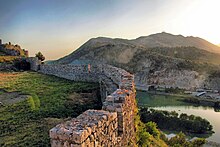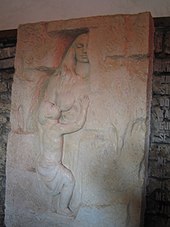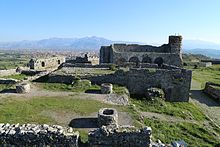Rozafa
| Rozafa | ||
|---|---|---|
|
The castle seen from the opposite bank of the Boyana |
||
| Creation time : | 4th century BC Chr. | |
| Castle type : | Spurburg | |
| Conservation status: | Essential parts preserved / ruins |
|
| Construction: | different stone construction methods | |
| Place: | Shkodra | |
| Geographical location | 42 ° 2 '48 " N , 19 ° 29' 38" E | |
| Height: | 130 m | |
|
|
||
The Rozafa Castle ( Albanian Kalaja e Rozafës or more rarely Kështjella e Rozafës , often just Rozafa for short ) is a ruined castle on the southern edge of the northern Albanian city of Shkodra .
location

The fortress Rozafa was built on a hill with a maximum height of 130 meters, which controls the outflow of Lake Skadar over the Buna in a strategically favorable position . The Drin and Kir rivers pass the hill to the south . The slopes of the hill are very steep and rocky up to the walls. The extensive area of the castle in the shape of an irregular triangle includes the rather flat hilltop. Access is from the east, where the hill continues at a lower elevation.
history
Already in the 4th century BC In BC Illyrians founded a city on the hill called Scodra , which is the predecessor of today's Shkodra. During Roman times it extended to the plain at the foot of the hill.
Later, Byzantines , local princes and Venetians used the facility. The latter greatly expanded the fortifications.
In 1479 the Turks were able to take the castle after ten months of siege. The castle was inhabited until the second half of the 17th century. It was not until 1863 that the administration of Vilayets Shkodra was moved from the castle to the city center. The castle was used for military purposes by the Ottoman army until 1913, when the Montenegrins conquered the city .
Genesis
The forecast by three brothers built the castle. Their efforts were in vain, however, as the walls collapsed every night. An old man advised them to wall up a woman. Then the walls would last forever. The three brothers agreed to sacrifice the one of their wives who would be the first to bring lunch the next day. Contrary to the agreement, the two older brothers let their wives know about the plan. So it was the young Rozafa who appeared first at the construction site the next day. She accepted her fate but asked that one of her breasts, an arm and a leg not be walled in. So she could continue to breastfeed her young child, stroke it and rock the cradle with her leg.
Rozafa is also a female given name derived from this .
investment
The Rozafa fortress is one of the most important sights in Shkodra and can be visited for a fee. There is a small museum and folk restaurant within the premises.
With the exception of the still solid fortification wall, which mainly dates from the Venetian era, most of the castle's buildings, including the rededicated St. Stephen's Church mosque, have been destroyed. Access to the castle leads through several gates and the massive outer wall. The area enclosed by this comprises three courtyards that were separated from each other by secured walls. The outer wall can be climbed in several places, from which one can enjoy the view over the city of Shkodra and Lake Skadar.
In the entrance gate, white limescale deposits hang down from the ceiling . These sintered tubes, compared with breast milk , are likely to have formed the origin of the Rozafa legend.
Web links
- Archaeologiepark Shkodra (English)
Individual evidence
- ↑ Skënder Luzati: Buildings and architecture in Shkodra: decline of a north Albanian metropolis , in: Werner Daum (editor): Albania - between cross and half moon , Pinguin Verlag, Innsbruck 1998, ISBN 3-7016-2461-5
- ↑ Legend of Rozafa shkoder.net, accessed January 7, 2016 .




